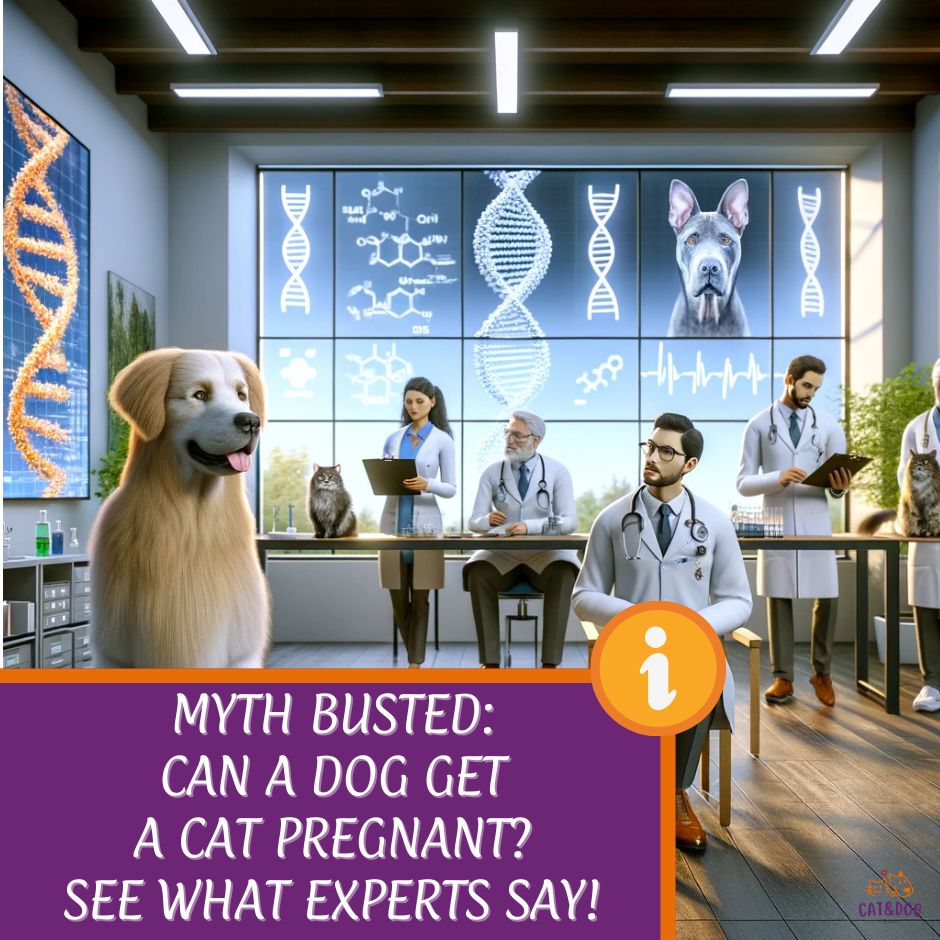If you’ve found yourself questioning, “Can a dog get a cat pregnant?” amidst the peculiar romance blossoming between your canine and feline under one roof, you’re certainly not alone.
However, the straightforward answer is no.
Despite the sometimes amusing and questionable interactions between dogs and cats, the reality is that crossbreeding between these two distinct mammals is biologically impossible due to significant differences in their reproductive systems. (1)
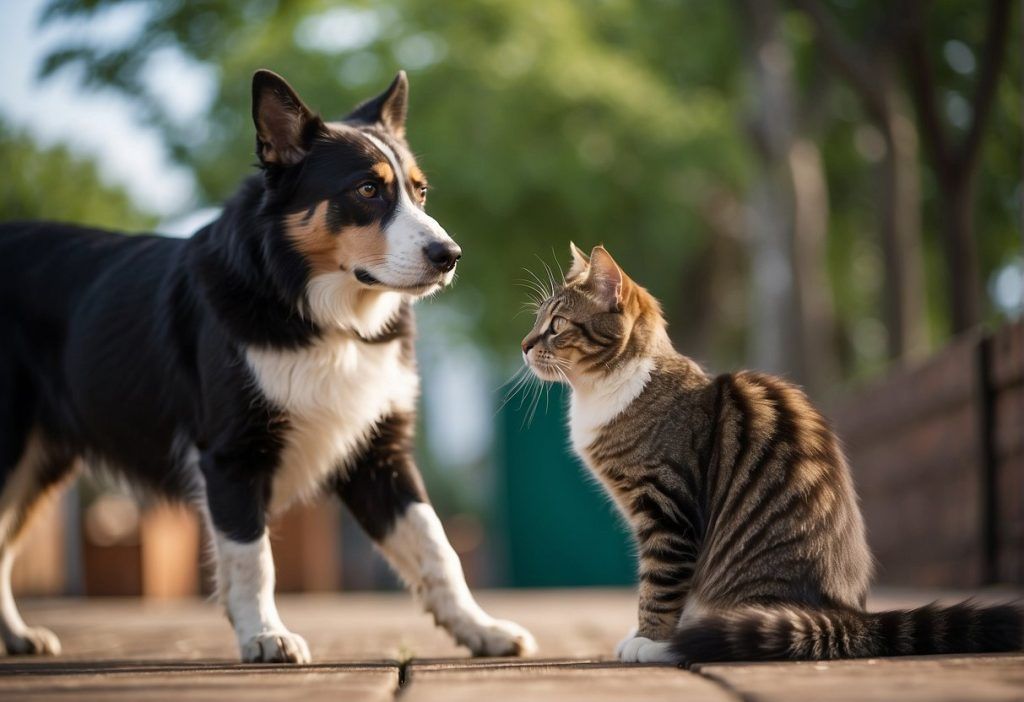
Now, let’s break it down to the nitty-gritty of why inter-species dating doesn’t lead to inter-species mating results.
When we talk about animals of different species, such as dogs and cats, we’re looking at a myriad of genetic and biological factors that determine their reproductive capabilities.
It’s all about the chromosomes, the DNA structures that carry genetic material. (2)
Cats and dogs have different numbers of chromosomes, meaning their genes just don’t match up in a way that would allow for successful breeding.
However, dogs can mate with other animals that have similar DNA, such as wolves or foxes, as they belong to the same family of animal species.
Additionally, their reproductive systems are not designed to align with each other, sealing the deal on the impossibility of such a cross.
While some animal species can be crossbred, cats and dogs are not among them, making it impossible for a dog to impregnate a cat.
Key Takeaways
- Dogs cannot get cats pregnant due to the incompatibility in their genetic and biological makeup.
- Chromosome differences and distinct reproductive systems are key reasons why dogs and cats cannot crossbreed.
- While some animal hybrids do exist, a dog-cat hybrid is not one of them, so pet owners need not worry about unexpected litters of ‘catdogs’.
The Science Behind Can a Dog Get a Cat Pregnant?
Ever wondered if those cartoons with cat-dog siblings were onto something? Spoiler alert: they weren’t!
When you look at your dog and cat lounging around, it’s clear they come from very different branches of the family tree. But why can’t these two popular pets make furry little hybrids?
Let’s start with the chromosomes. Your dog has a whopping 78 chromosomes, while your cat possesses a smaller set of 38 chromosomes.
Why does this matter? Well, chromosomes are like nature’s recipe book, and each species has its own unique set.
Geneticists affirm that for breeding to be successful, those sets need to complement each other perfectly.
In the case of dogs and cats, it’s like trying to make a smoothie with a recipe for a cake – the ingredients just don’t mix!
Here’s a simple breakdown:
- Dogs (Canis familiaris): 78 chromosomes
- Cats (Felis catus): 38 chromosomes
When a vet says your pets are incompatible, they’re not being quirky; they’re stating scientific facts.
The DNA of dogs and cats is too different, like trying to fit a square peg in a round hole. There’s just no clicking! (3)
Here’s what a leading veterinarian had to say:
“It’s not just about the numbers; it’s about compatibility. A male dog’s sperm is as foreign to a cat’s reproductive system as a flea treatment for fish. There’s simply no way for the two to produce offspring.”
So, next time your cat and dog get a little too friendly, don’t expect a flurry of “pittens” or “cuppies.” You can rest easy knowing that in the world of genetics, some boundaries just can’t be crossed.
Keep enjoying the playful banter between your dog and cat, knowing their connection is strictly platonic and that they both have different nutritional needs, with dogs requiring dog food and cats requiring cat food.
Exploring the World of Animal Hybrids
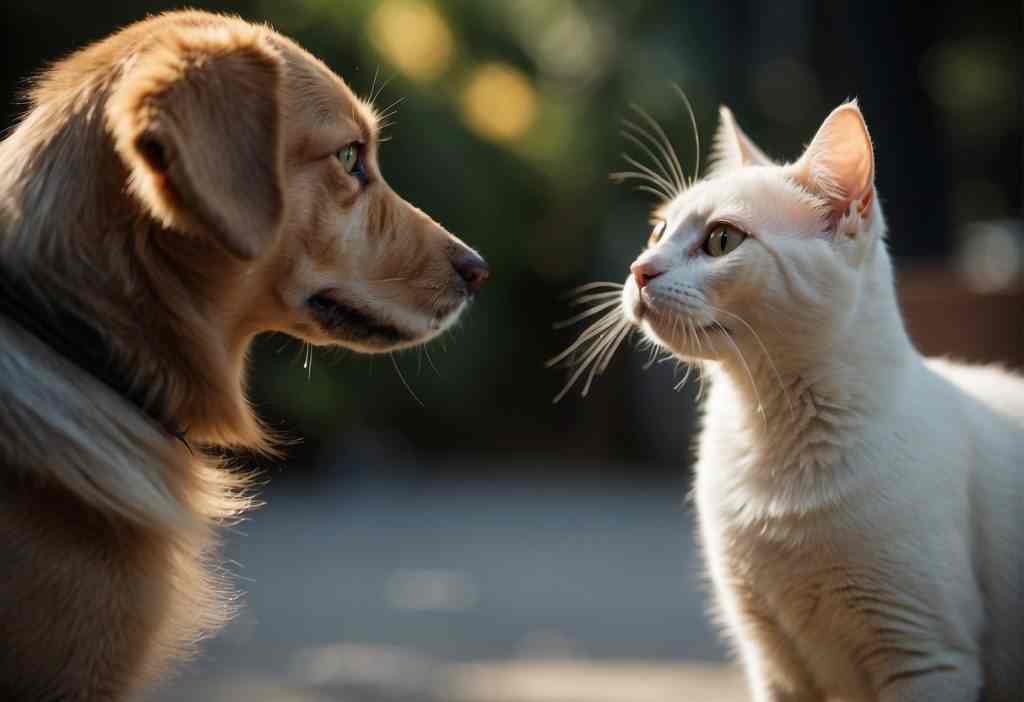
Let me tell you, in the world of nature, some pretty cool mash-ups do exist!
Take the liger for instance – no, it’s not a character from a fantasy novel. It’s the real-life offspring of a male lion and a female tiger.
These big cats can tell you a thing or two about compatibility. They’ve got the right number of chromosomes to tango.
And then there’s the mule, born from a male donkey and a female horse. These hardy hybrids are well-known work animals with a mix of their parents’ best traits.
Additionally, wild cats like servals, leopard cats, caracals, fishing cats, and sand cats, as well as jaguars and zebras, can also mate with domestic cats, creating unique hybrid offspring.
This phenomenon of animal hybrids highlights the fascinating world of animal reproduction and the potential for unexpected combinations, such as jaglions or dog-cats.
And let’s not forget about the coydog, a hybrid of a coyote and a dog, or the zebroid, a mix of a zebra and a horse. The possibilities are endless in the world of animal hybrids.
But let’s dispel a myth. You might be asking, “Can a dog and a cat have a love child?” It’s like trying to charge your phone with a banana – an interesting concept, but it not happening.
Dogs and cats are like two puzzle pieces from different boxes; they just don’t fit together to create offspring.
- Genetic Compatibility:
Dogs and cats have a different number of chromosomes; dogs have 78, while cats have 38. - Successful hybrid animals usually come from genetically closer species.
So, while hybrid vigor can be a thing, it’s not in the cards for our canine and feline friends. Attempts at creating the mythical “cat-dog” are just that – myths.
To get a bit sciencey, hybrids often need a helping hand from human intervention, like controlled breeding programs. It’s not just a stork delivery service; there’s science involved!
Knowing this, you can look at animal hybrids with a sense of wonder about nature’s possibilities, and also its limits.
Remember, even in nature, there are rules to play by – and breaking them is not as simple as mixing paint on a palette. Keep exploring, the world is full of wonders!
Practical Advice for Pet Owners
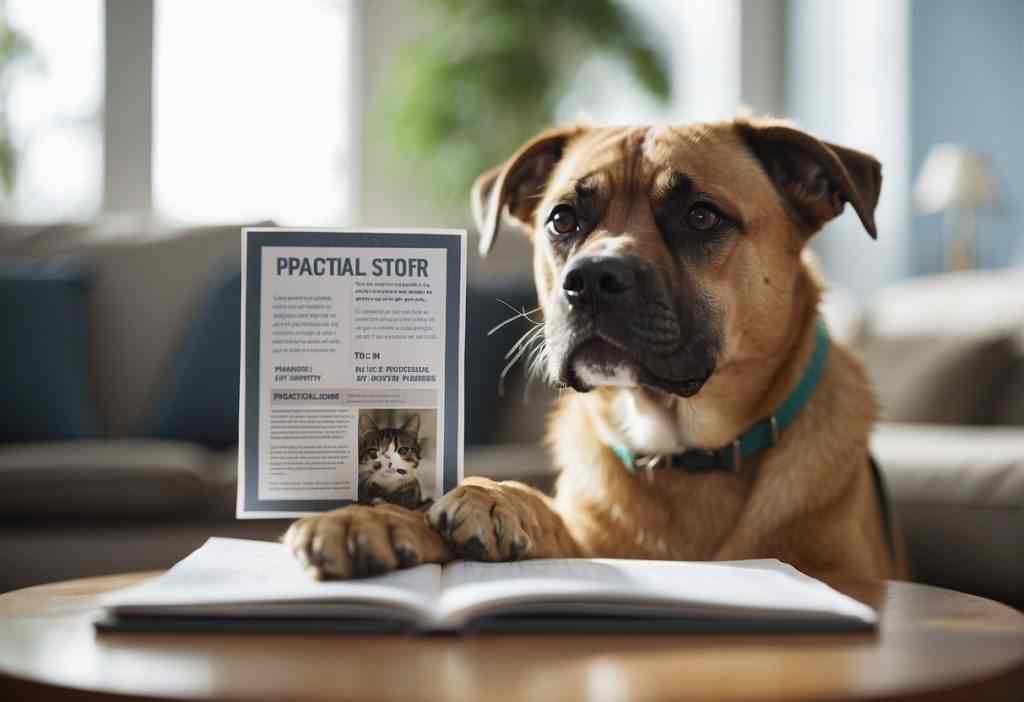
When you’ve got both dogs and cats under your roof, ensuring they get along is like overseeing a mini ecosystem!
Now, I know you might chuckle at the sight of your doggo trying to charm the resident feline, but let’s clear this up: a dog cannot get a cat pregnant. It’s just biology!
Keeping the peace is about respecting their instincts. So, here’s your mini-guide:
- Spay or Neuter:
This is a biggie! It not only prevents unexpected litter but also curbs those enthusiastic advances. (4) - Behavioral Training:
Establishing good manners is crucial.
- Use positive reinforcement when your dog exhibits calm behavior around your cat.
- Redirect any unwelcome mating attempts with toys or treats.
- Use positive reinforcement when your dog exhibits calm behavior around your cat.
- Personal Spaces:
- Cats: They love a good perch. Make sure your kitty has a high-up spot to escape to.
- Dogs: They usually don’t climb, so the floor is their turf. Ensure they have a comfy bed.
- Cats: They love a good perch. Make sure your kitty has a high-up spot to escape to.
- Introduce Slowly:
If they’re new roomies, take it slow. Short, supervised meetups can build trust.
Remember, your furry pals want to live in harmony just as much as you do. They just need a helping paw to figure it out!
Keep an eye on their interactions, and step in if you spot any funny business. Your home can be the purr-fect haven for dogs and cats to coexist—playful banter, occasional chase scenes, and all.
Just remember, it’s about creating a loving environment for both, not a soap opera set. Keep it lighthearted, keep it respectful, and you’ll all be just fine.
Enhancing Understanding Through Visuals
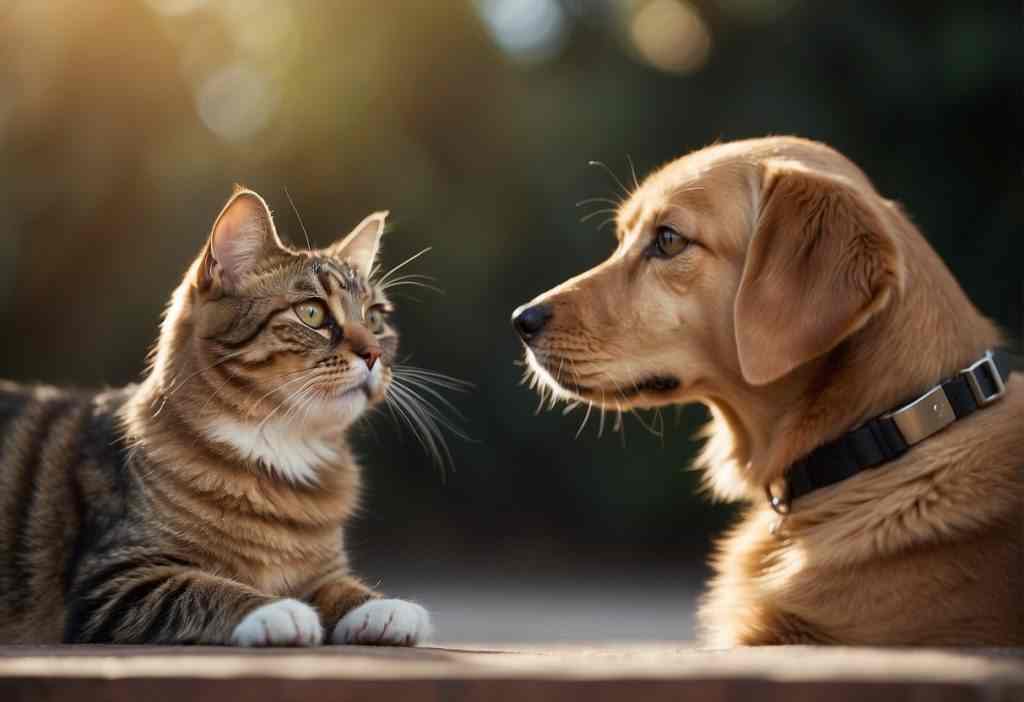
Let’s get a clear visual picture! Have you ever seen an infographic? They’re like comic strips for facts, and boy, do they tell a story when it comes to our pets’ genetics.
Imagine an infographic illustrating genetic differences. On one side, you’ve got your dog, with a whopping 78 chromosomes.
Now, glance over at your cat, lounging with their modest 38 chromosomes. This isn’t just about who has more; it’s a game of match-making, where the pieces simply don’t fit!
Here’s a quick breakdown:
- Dogs: 78 chromosomes
- Cats: 38 chromosomes
And for a dynamic twist, how about we throw in some educational videos to show the magic of DNA? Think of DNA as a recipe book.
Each species has its cookbook, and just like you can’t bake a pie using instructions for a steak, dogs can’t make kittens!
To help it all click, consider this:
- Infographics: For a snapshot of the impossibility
- Videos: To break down why dog DNA and cat DNA create different animals
With bold and vibrant visuals, grasping the concept of why dogs and cats can’t cross the species date line is a walk in the park – or a cat nap in the sun!
So keep your eyes open for snazzy charts and straightforward clips that make the intricate world of genetics as simple as fetch.
Advanced Topics in Animal Genetics
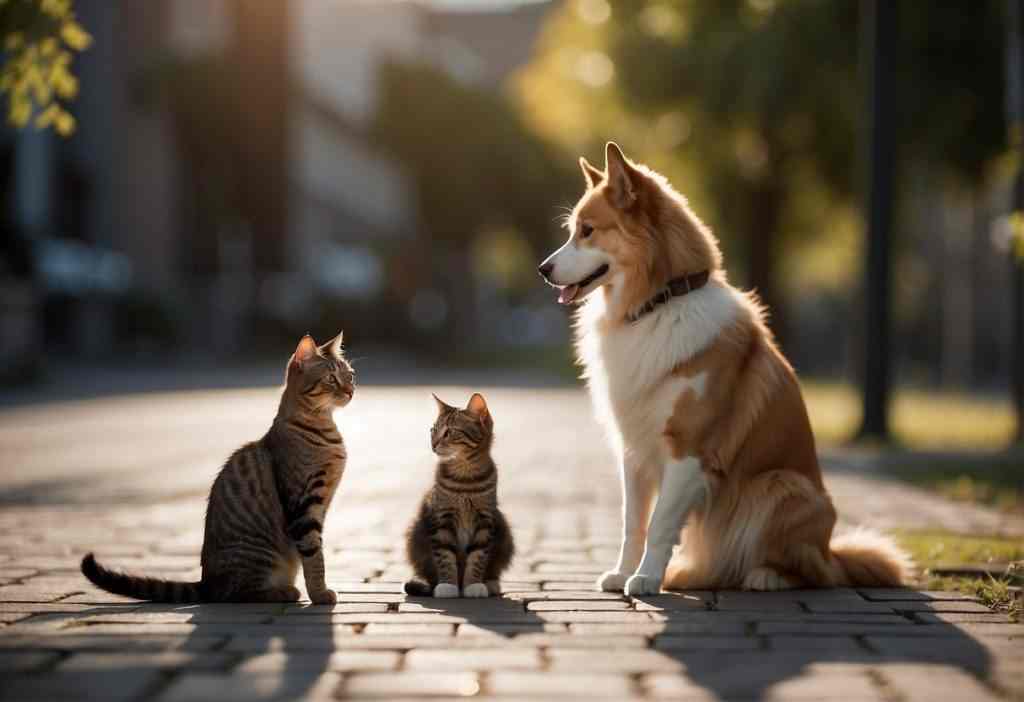
Well, it’s all down to the complex world of animal genetics, including the work of Roy Tutt, who famously attempted to cross-breed cats and dogs.
Let’s unpack some of the mysteries behind why different species, like dogs and cats, just can’t seem to produce offspring together, even if they get “friendly” in December.
One of the people who tried cross-breeding cats and dogs was Roy Tutt (Wright, 2015).
In December 1970, Tutt released an advertisement saying he accepted offers for a “half cat-half dog” hybrid with a dog’s head and a cat’s whiskers, furs, and legs.
According to his statement, this hybrid was a combination of both species’ features, including the unique cat’s whiskers.
Animal genetics plays a gatekeeper in the mating game, ensuring species often remain, well, with their kind.
Here’s a quick rundown:
- Prezygotic barriers:
These are the obstacles that prevent species from mating in the first place. (5)
- Different mating behaviors:
Your cat might not appreciate your dog’s “advanced techniques” if you get my drift! - Incompatible reproductive organs:
Like trying to fit a square peg in a round hole, right?
- Different mating behaviors:
- Postzygotic barriers:
If by some miracle different species do mate, postzygotic barriers make sure that the resulting embryos do not survive or that any hybrids are infertile.
- Genetic incompatibility:
Dog and cat DNA is as mixable as oil and water. No common genetic ground means no little hybrids.
- Genetic incompatibility:
Alright, but why does your dog chase its tail and your cat ignores you unless it’s dinner time? Genetics influences behavior, too. (6)
Genes can dictate personality traits, and studies have shown that certain genetic markers are associated with specific behaviors.
Now, while we haven’t seen any cogs running around—thanks to these genetic barriers—exploring genetics gives you a deeper appreciation for the diversity and complexity of animal life.
Just remember: In the grand tapestry of life, not every thread is designed to weave together. Keep these little genetic tidbits in mind the next time you catch your furry friends in a peculiar tango!
Quick Recap
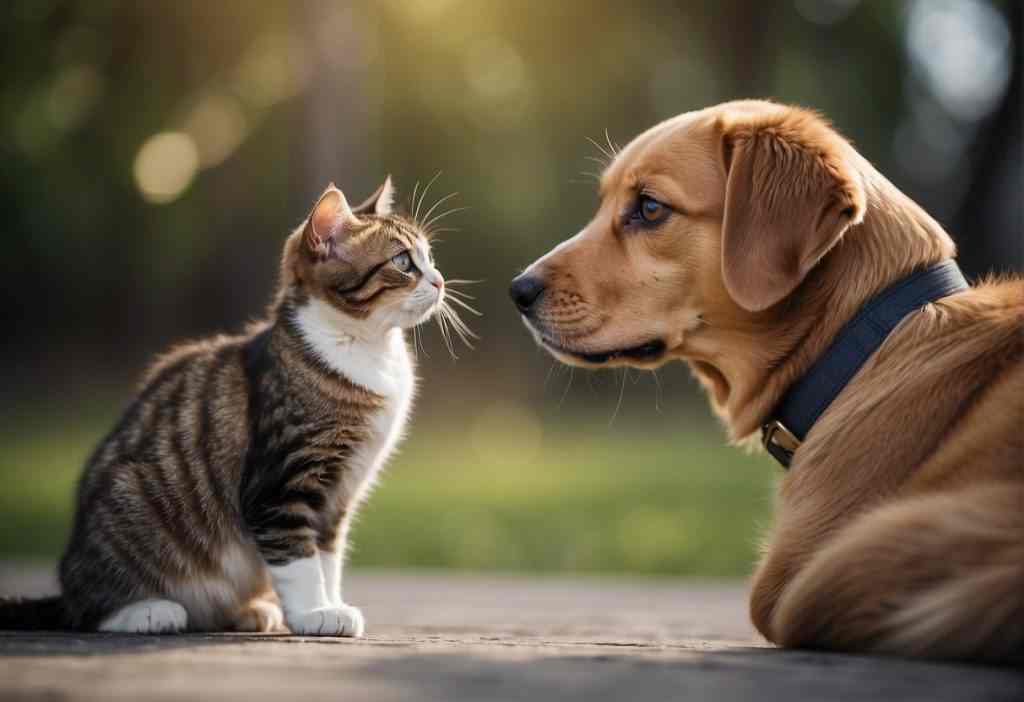
Let’s clear up the confusion with some quick facts.
Can dogs impregnate cats? No, they can’t. The biology of dogs and cats is fundamentally different — like trying to fit a square peg in a round hole. Let’s break it down:
- Genetics: Cats have 19 pairs of chromosomes, while dogs have 39 pairs. It’s like having a lock and key from two different sets; they just don’t match.
When you see dogs trying to get chummy with cats, remember, it’s a no-go zone for creating hybrids. Dogs might not understand species barriers, but nature sure does.
Dogs can be quite flirts, but when it comes to making babies, they stick to their own.
If you’re a pet parent, you might giggle at your dog’s misguided amorous efforts. But it’s also a moment to think about responsible pet ownership.
If you’re scratching your head over your pet’s quirky behaviors or have any concerns, who do you call? Your friendly neighborhood vet. They’re there to translate those barks and meows into peace of mind.
To sum it up: A cat plus dog equals a whole lot of cute but zero kittens or puppies. Their genetic recipe just doesn’t mix.
Remember, when it comes to our furry friends’ well-being, always keep your vet on speed dial for the real scoop!
Frequently Asked Questions
You’ve got questions, and we’ve got answers.
Let’s dive into the intriguing world of pet genetics and behaviors with some of the most common curiosities you might have about your furry companions.
Can dogs and cats have mixed offspring?
No, dogs and cats cannot produce mixed offspring. Their genetic makeup is drastically different, with dogs boasting 78 chromosomes and cats only 38.
Why do dogs sometimes try to mount cats?
Dogs might try to mount cats for a variety of non-sexual reasons, such as play, domination, or stress relief. It’s not a sign of actual mating intent.
What are some real examples of animal hybrids?
Real animal hybrids do exist in species with compatible genetics, like the mule, which is a cross between a horse and a donkey, and the liger, from a lion and a tiger.
How can I prevent my dog from trying to mount my cat?
To prevent your dog from attempting to mount your cat, keep them exercised and mentally stimulated.
Consult a vet or a professional trainer if the behavior persists.
Are there any successful cases of very different species mating?
Successful mating between vastly different species is virtually non-existent due to genetic incompatibilities, which rule out the viability of such hybrids.
What does interspecies breeding tell us about animal genetics?
Interspecies breeding highlights the importance of genetic compatibility for successful reproduction.
It showcases the complexity and specificity of animal genetics.
How do genetics influence animal behavior?
Genetics plays a significant role in determining animal behavior, influencing traits like temperament, socialness, and instincts, which are passed down through generations.
- Free Online Casino Games: What You Need to Know - July 26, 2025
- Ideal Casinos Mobile: The Ultimate Guide to Mobile Betting - July 26, 2025
- The Ultimate Overview to Casino Site Gamings Online - July 26, 2025

